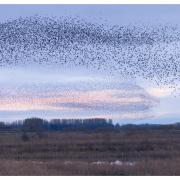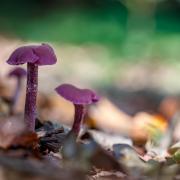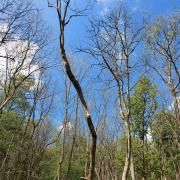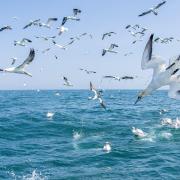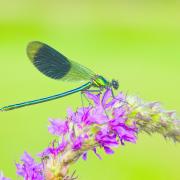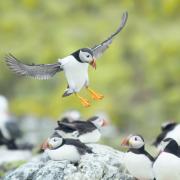Winter is the perfect time to enjoy an easily overlooked but striking group of birds – the thrushes, as Tom Marshall from Yorkshire Wildlife Trust reports

Some birds get all the limelight. The attention-seeking drumming of the woodpeckers, the vibrant plumages of the tit and finch families, or the globe-trotting flag bearers of the seasons like the swallow and cuckoo.
And yet, there is a group of birds that can bring joy to every single day with their quiet (and not so quiet) antics, from the first days of spring to the harshest of crisp winter mornings: the thrushes.
The most ubiquitous of this feathered cast is of course the blackbird, featuring in the RSPB’s Big Garden Birdwatch top ten since the survey’s inception in 1979, and perhaps Britain’s most abundant breeding bird with some six million pairs – that’s one for every five of us.
Like many in the thrush family, the blackbird’s straightforward attire belies a serious skill set when it comes to singing. Alongside a super-group of others such as the robin and wren, the blackbird has a lyrical prowess that we can enjoy for at least half of the year and a role in the dawn chorus that it clearly takes very seriously. Outside of the usual melodic repertoire, it’s not unusual for blackbirds to throw in the odd contemporary twist too, with car alarm impersonations among some of their less preferred releases.

Such was the quintessential Britishness of the blackbird that they travelled with early settlers as far afield as Australia and New Zealand where they have made themselves equally at home, and have even made it on to antipodean Garden Birdwatch survey lists.
For true X Factor impact however, few can beat the aptly named song thrush. So confident are they in their back catalogue that song thrushes may continue to sing throughout much of the year, always choosing centre stage atop a tree or carefully selected rooftop TV aerial. That gorgeous cream and arrow-head scattered breast was once a classic back-lawn feature, with their favoured prey of snails and the use of a hard stone or ‘anvil’ to crack the shells being endlessly watchable.
Although not yet lost from our gardens, a 50 per cent decline between the 1970s and 1990s has put the song thrush in a less enviable position, with contemporary impacts like the increase in artificial grass and garden pesticides unlikely to offer any respite to its bid to remain high in the charts.
Rather larger, paler and somehow less familiar, the mistle thrush has a song ready to rival its cousins, but is more at home among the fields and hedgerows than our backyards. The ‘mistle’ comes from mistletoe; a favourite food on the continent but with rowan, cotaneaster and holly more likely to make the menu in Britain. Such is the mistle thrush’s territorial nature and ability to see off all comers, it also carries the name of ‘storm cock’ – a reflection of its unrelenting ability to keep singing in the most exposed locations, whatever Mother Nature throws at it.

Despite recent population declines, we still remain blessed with millions of blackbirds, song thrushes and mistle thrushes, but these resident songsters are swelled in numbers during winter by Scandinavian and continental visitors heading to Britain, all keen to make the most of our berry bonanza and relatively mild temperatures.
Doing its best to impersonate a song thrush, the redwing is one such Nordic traveller and is often the first to arrive during October, or earlier in harsher years. A little smaller than a song thrush or blackbird, that cherry-red underwing is only given away as the slightest hint on the ground, with the pale eye strip a more likely point of difference. When they take flight however, that burst of colour is clear to see, and their roving flocks along the windswept bushes of the Yorkshire coastline are a sure sign that autumn has arrived.
With aerial predators also on the move, redwings choose to undertake their southerly excursion at night, with their ‘contact calls’ among large flocks a favourite of birdwatchers able to pick them out in the inky darkness. Such is the effort involved in reaching the life-giving berries of Britain that, on arrival, exhausted redwings may allow for an uncharacteristically close approach, with their more typical shy behaviour soon returning as they build up energy for the winter ahead.
Perhaps the most distinctive of our winter thrushes is the fieldfare, just a little smaller than a mistle thrush and boasting a head the colour of stormy skies, a caramel breast speckled with darting black chevrons and a chocolate brown back. Highly sociable, fieldfares are often spotted on the move in large flocks, their noisy, crackling call breaking through the chilliest of sub-zero winds. Happiest gorging on a bush bending under the weight of cotaneaster or hawthorn berries, they’re also partial to windblown apples and leaving a little fruit out during hard frosts is a sure fire way to attract them into your back garden.

Unlikely to cause a stir during their winter sojourn here in the UK, back home in their northern forest breeding territories, fieldfares employ aggressive ‘bombing’ tactics to see off predators. With carefully considered precision, the birds will aim droppings at the backs of would-be intruders, with the aim of rendering other birds unable to fly easily with a coating of sticky droppings.
- The blackbird is our most numerous breeding thrush, and with a song that more than makes up for its plain appearance

- With a penchant for windblown apples and winter berries, the fieldfare is a striking seasonal visitor arriving in October
- Our largest thrush, the ‘storm-cock’ or mistle thrush will happily see of all comers whatever the weather
- The aptly-named redwing adds a splash of autumn colour to our hedgerows, also told apart by a distinctive eye stripe
- The song thrush has fallen in numbers in recent years, but its lyrical repertoire remains a firm favourite throughout much of the year
- After a journey across the North Sea, redwings can arrive exhausted on the Yorkshire Coast, and even be obliging for a selfie!
Berry enticing
For all thrushes, a good crop of berries is almost irresistible. While the wild and windswept hedgerows of Flamborough, Bempton and Spurn Point may be the first choice for a meal on arrival to Yorkshire, you can do plenty to attract them into your own garden too.
Mountain ash or rowan can deliver a spectacular crop of orange berries, while cotaneaster and hawthorn make a great alternative. With many of our traditional orchards lost in recent decades, a scattering of apples during a hard frost or snow will be gladly received – a particular favourite with fieldfares. Keeping a traditional lawn and minimising garden pesticides will allow for a few slugs and snails, plus earthworms too – a welcome treat when the frosts thaw in spring..
Share your wild stories
We love sharing the best of Mother Nature with you every month, but we’d like to hear about your wild encounters from here in Yorkshire too. Send us your nature memories, pictures or questions via letter, Facebook or Twitter @Yorkshire_Life.












